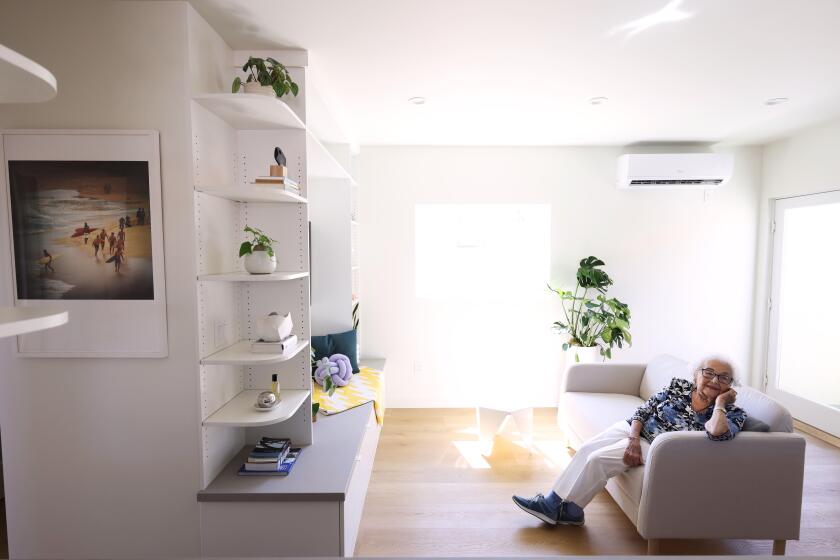Redesigns on Itself : The Pacific Design Center moves from exclusivity to accessibility. How better to attract a new clientele?
They lined up on the amphitheater steps as if awaiting a firing squad. David Hockney, the museum-quality pool painter, gesturing madly with his cigarette. Designer Sally Sirkin Lewis writhed uncomfortably under the spotlight, while Saul Bass, the diminutive giant of graphic design, adopted the frozen stance of a garden gnome.
None of the 20 architects, artists and designers wore their fame easily as the Pacific Design Center inducted them into its version of the Hollywood Walk of Fame.
This was a big moment--a way of commemorating the center’s 20th anniversary--during the annual design symposium West-Week, which concluded on St. Patrick’s Day. After 10 minutes’ worth of introductions, the unveiling of the awards (stars crafted of white porcelain-coated steel and embedded in concrete) and a brief round of applause, the people in the furnishings industry hunkered down to prepare for a new way of doing business.
The WestWeek seminars and showroom buzz attested to the concerns of a wholesale business that is shedding its bullion-fringed cloak of exclusivity to become more accessible to the public.
At the first talk, “It’s All About Style: Furniture and Fashion, a Natural Connection,” architect John Saldino waxed eloquent about interiors being walk-in art. Lofty played well with the audience.
But Donna Warner, editor of Metropolitan Home magazine, broke the spell. She suggested that when designers gave women comfortable, affordable clothes, those women lost interest in fashion. Now that comfy-eclectic had penetrated home design, might people lose interest in decorating?
Twitching and seat-shifting were the crowd’s response. And that became a recurring theme of WestWeek: high ideals goosed by realities. The four-day event was less about trends than it was about how to court new business.
Meanwhile, in the Mimi London showroom, salesman Michael Savoia steered customers toward the latest works by Los Angeles architect and furniture designer Nick Berman. “He’s brought the prices down, and the comfort level up, “ Savoia announced proudly.
Not that Berman’s cherrywood side chairs were torturous at a four-figure price, but they’re just so soothingly squishy and easier to sell at $600. Years of design experience helped him make the chairs more comfortable, Berman said. Less expensive woods such as maple led to the lower price.
In another corner of London’s showroom was an armchair that solves two vexing problems with leather furniture. Its upholstered seat in a non-skid fabric isn’t slippery, and it can be replaced when it wears out. The upholstery also gives the chair a homespun look, which is a compelling selling point.
People are experiencing “decoraphobia,” said Los Angeles-based designer Joe Ruggerio. “The craft (touch) says loving hands at home, and that is comforting.”
Other examples of the style are hand-painted poster beds, Shaker-inspired pieces in color washes, and a resurgence of French Provencal. (Yes, that white stuff with gold trim known generically in America as girls’ bedroom furniture. This new decorator version is colored a rich ivory with hand-painted floral trim in burnished gold.) Even cabinetry has a folksy feel: The Italian company Snaidero re-creates a kitchen like the one June Cleaver baked brownies in.
Also sighted:
* Three-dimensional-looking drapery fabrics such as eyelash embroideries and shadow stripes, at Jack Lenor Larsen and Randolph & Hein.
* Bamboo-patterned steel table legs, at McGuire; mixing exotic wood tops with metal legs is a popular combination in tables.
* Low-profile beds, at multiple showrooms. After several years of poster beds that scraped the ceiling, they’re hugging the floor.
* You-design-it furniture. The Baker 9000 line, at Baker Knapp & Tubbs, is made for people who want options. “People want to choose the arm, leg and skirt styles,” said showroom manager Patricia Logan.
* Colorful pre-stained floors, at Walker Zanger. Stripe, chevron and square patterns in rainbow colors are feasible, even if they’re not desirable.
* Idea House, a two-bedroom loft designed to stimulate dialogue between designers and their customers. “It’s the place to come and ask the stupid questions,” said Ruggerio, who designed the loft. “The showrooms don’t have the time or the personnel to educate the customer. Here, we do.”
An invitation to ask stupid questions? The climate at the Pacific Design Center has changed from frosty to downright warm and fuzzy.






